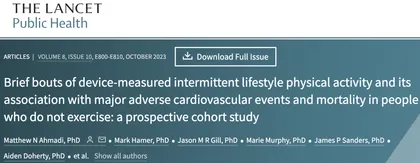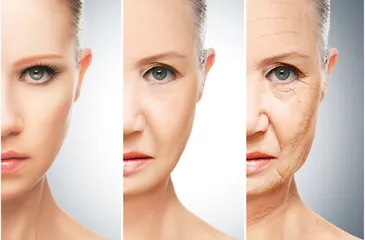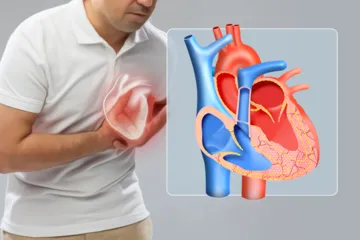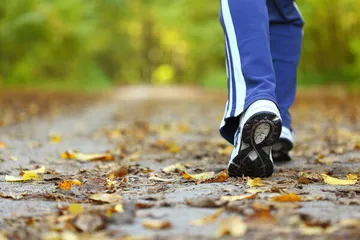Excessive exercise or life loss, reminder: 3 types of exercise are suitable for lazy people, do what you can
"Honey, I'm sorry, actually, one minute is too long!"
Mr. Zhou, who had just "paired sports" with his wife, couldn't help but apologize to his wife.
Mr. Zhou works in a bank and usually sits in his seat all day. He often works overtime and has no time to exercise. In the long run, Mr. Zhou felt that his body began to feel unwell and could not continue like this. He took advantage of dinner and took advantage of the opportunity to play "high-intensity pairs sports" with his wife.
I didn't expect to break through after only one minute, and I was ridiculed by Mrs. Zhou!

Mr. Zhou chose a flat support, but shortly after the beginning, he felt his hands sore and legs shaking, making it difficult to hold on, and he was sweating profusely.
After finally holding on for about 10 minutes, Mr. Zhou collapsed to the ground, took out his mobile phone, and took a closer look. He had only lasted for 1 minute!
He apologized to his wife dejectedly and defended himself: It's been a long minute! Recent research shows that even 1 minute of exercise every day is enough to extend life.
Mrs. Zhou was skeptical: How can there be such a cheap thing in the world? Show me the research.
1. Heavy new research: 1 - 3 minutes of moderate to high-intensity intermittent lifestyle exercise may prolong life. In October, researchers at the University of Sydney published a heavy study in the Lancet Public Health. They found for the first time that 1 - 3 minutes of moderate to high-intensity intermittent lifestyle physical activity (MV-ILPA) per day can reduce the risk of death.

What is medium to high intensity intermittent lifestyle physical activity? Let's explain it one by one.
Medium and high intensity: The so-called intensity refers to the rate at which the body does work during activity. More popularly speaking, it refers to the amount of force used by the body during activity. If you want to reach moderate to high levels, your heart rate should reach 60% to 80% of the maximum heart rate (220-age) during exercise.
Intermittent: intermittent, discontinuous.
Lifestyle physical activity: Physical activities in daily life such as rushing buses, climbing stairs, walking quickly to work, and carrying loads of shopping.

researchers collected data from 25409 adults who had no habit of exercising. The average age was 61.8 years old. Women accounted for 56.2%, and the average follow-up was 7.9 years. The findings are as follows: 1. Moderate to high-intensity intermittent lifestyle physical activity, the longer the duration, the more benefits. Compared with people who exercise for less than 1 minute, the duration of exercise can reach 1 to 3 minutes, and the risk of adverse cardiovascular events is reduced by 29%, and the risk of death is reduced by 34%; if exercise lasts for 3 to 5 minutes, the risk of adverse cardiovascular events is reduced by 38% and the risk of death is reduced by 44%; Exercise duration can reach 5 to 10 minutes, the risk of adverse cardiovascular events is reduced by 41%, and the risk of death is reduced by 41%.
2. Medium-to-high intensity intermittent lifestyle physical activity, even if it is less than 1 minute, will be beneficial for less than 1 minute. Vigorous exercise accounts for more than 12% of medium-to-high intensity intermittent lifestyle physical activity, and the risk of death is significantly reduced, accounting for more than 15%, the risk of adverse cardiovascular events has also begun to decrease.
Basically everyone knows the truth that exercise is good for health. The World Health Organization also recommends 150 to 300 minutes of moderate-intensity exercise or 75 to 150 minutes of high-intensity exercise every week. However, many people are busy at work, lack of time, lack of space, laziness and other reasons. Can't exercise frequently.
This study tells us that exercise may not require special places, equipment, or a lot of energy to gain benefits. Maybe walking faster to work and climbing stairs faster home can improve your health.

2. Don 't be "superstitious" about sports, which may harm your health and your life!
Many people work hard to exercise for health, as if the more "hard" exercise, the better it is for their health. However, exercise can make people healthy and can also hurt people. According to statistics, the incidence of sports injuries is about 10%-20%, such as sprain, fractures, tendon tears, etc. caused by exercise.
Once the duration, frequency, and intensity of exercise exceed the limit that one's physiological functions can normally withstand, it can cause a blow to the body in many aspects.
1. Accelerate aging When you exercise a lot, your body breathes faster and will inhale more oxygen than usual. However, too much oxygen may have toxic effects on normal cells of the body. In order to avoid oxidative damage, cells will convert 2% of it into oxygen free radicals. Free radicals are associated with a variety of diseases. They can also damage biological macromolecules such as proteins and enzymes, cause inflammation and accelerate aging.
网站图片位

2. Reduce immunity Free radicals produced by excessive exercise may also induce apoptosis or death of neutrophils and DNA damage of lymphocytes, resulting in decreased immunity.
3. Damage to liver and kidney function Excessive exercise will lead to the redistribution of blood flow in the body. During exercise, the blood flow in the liver and kidneys is reduced, and the greater the intensity of the exercise, the more blood flow will be reduced. After the exercise, the blood flow will return to normal irrigation again. This may cause ischemia and reperfusion injury, cause calcium overload, and further damage liver and kidney cells.
4. Damage to the heart, or even sudden death. Any strenuous exercise may lead to sudden death. During strenuous exercise, the burden on the heart will increase and more work will be required than usual. In the long run, the structure and shape of the heart may change, and its function and endocrine secretion will also be affected.
The incidence of sudden death from sports in ordinary people is about 0.9/100,000. Excessive exercise may lead to fatal arrhythmia and sudden death on the basis of original abnormal heart structure and heart disease.
网站图片位

5. Anemia There is a disease called "exercise anemia." If you exercise too much, your body will shed a lot of sweat. In addition to water, these sweat components also include metal ions such as iron ions. If your body lacks a large amount of iron ions, it may cause iron deficiency anemia.
Exercise does not mean that you practice more, the better. Everything must be moderate. The World Health Organization recommends 150 to 300 minutes of moderate-intensity exercise or 75 to 150 minutes of high-intensity exercise every week. It is suitable for most adults and can refer to exercise.
When you start exercising, don't strive to reach medium to high intensity at once. You can proceed step by step.
For people who do not meet the World Health Organization's sports recommendations, they can also engage in moderate to high-intensity intermittent lifestyle physical activities in daily life.

3. How to exercise in daily life?
1. Take less elevators and more stairs. Recently, a study by Peking University found that climbing 50 steps (about 5 floors) a day can reduce the risk of heart disease by 20%. When climbing stairs, you need to overcome the influence of gravity and constantly lift your legs, which can exercise the leg muscles well and also help improve blood circulation.
Warm reminder: Some people with poor knee joints and obese people are not recommended to climb stairs frequently to avoid damage to the knee joints.
2. Walking quickly to and from work Generally speaking, walking 120 to 140 steps per minute can be defined as walking quickly. Walking quickly can coordinate the muscles of the whole body to exercise together, promote blood circulation, and enhance myocardial contraction. It is also relatively safe. Walking quickly during commuting can also reduce the probability of being late for work, so why not?
Warm reminder: It is best to hold your chest high and keep your head high. The pace should not be too big to avoid tearing ligaments due to excessive steps.

3. Commuting/traveling by bicycle If the company is not far from home, you can commute by bicycle. If you need to go out to nearby places, you can also go by bicycle. Riding can directly exercise leg muscles, and may also promote blood circulation throughout the body. It can also drive small movements in the upper limbs and trunk, train the body's balance and make the body more flexible.
Warm reminder: It is best to warm up before riding a bicycle, and the seat cushion should also be adjusted to a suitable height. For men, the riding time should not be too long to avoid oppression of the reproductive organs and increased temperature affecting sperm.
Exercise does not require too complicated forms, nor does it require too much energy and time. By taking a few minutes of time out every day, you may be able to gain a lot of benefits.
References: [1] Ahmadi MN, Hamer M, Gill JMR, et al. Brief bouts of device-measured intermittent lifestyle physical activity and its association with major adverse cardiovascular events and mortality in people who do not exercise: a prospective cohort study. Lancet Public Health. 2023;810:e800-e810.
[2]Zimin Song, Li Wan, Wenxiu Wang, Yueying Li, Yimin Zhao, Zhenhuang Zhuang, Xue Dong, Wendi Xiao, Ninghao Huang, Ming Xu, Robert Clarke, Lu Qi, Tao Huang, Daily stair climbing, disease susceptibility, and risk of atherogenic cardiovascular disease: A prospective cohort study, Atherosclerosis, 2023, 117300, ISSN0021 -9150 [3] Wang Kai, Duan Haiyun. Research on the risk of sudden exercise-induced death in exercise and fitness and its preventive measures [J]. Bulletin of Sports Science and Technology Literature, 2021, 2906:1-2+29+41.DOI:10.19379/j.cnki.issn.1005-0256.2021.06.001.
[4]Liu Zhigang, Liu Qin, Zhang Chaohui. Physical fitness is not better-On the harm of excessive exercise [J]. Journal of Honghe University, 2016, 1406:104-106+110.
[5]Cui Jingzhi. Feel the top 10 benefits of cycling [J]. China Bicycle, 201503:138-139.
Reprinting is prohibited without the author's permission and authorization